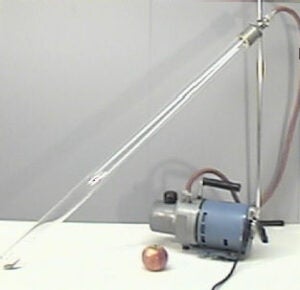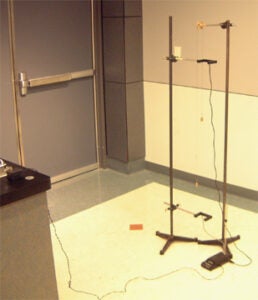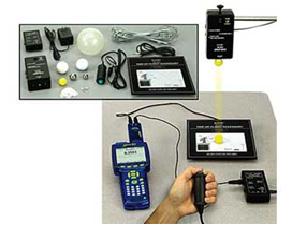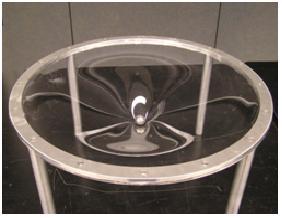M.7(1) – Coin and Feather Tube
This demonstration shows the coin and the feather falling with the same acceleration and striking the tube’s bottom at the same time. The apparatus consists of a glass tube 1 m long and 4.5 cm in diameter with brass caps, stopcock at one end, and supported on a tripod. The vacuum pump is connected to the hose connector in the base. Evacuate the tube, close off the stopcock and remove the hose. The apparatus can be spun around its support arm. The coin and feather will fall at the same rate. Very occasionally the feather sticks at one and and must be dislodged by shaking the apparatus.

Click here to see a video of this demo.
M.7(2) – Atwood Machine
It has a ball-bearing pulley on an upright support mounted on a tall stand. A cord carrying mass holder passes over the pulley. Different masses are provided for attachment to the mass holders. Together, they form a constant mass system. One of the mass holders is kept slightly heavier. This holder is then released from near the top and falls pulling the cord over the pulley behind it. Acceleration is determined by measuring the time taken for the heavier mass to reach a certain point at the bottom of the stand.

M.7 (3a) – Falling Body Experiment
The goal of this experiment is to demonstrate how the acceleration of gravity may be measured. This is completed by placing the steel ball in the holding mechanism a distance h above the impact sensor. Once the steel ball is released, an electronic timer will begin and finally halt once the steel ball has hit the impact plate. The free fall time, t, can then be used along with the distance h to calculate the acceleration of gravity.


Click here to see a video of this demo.
M.7 (3b) – Falling Body Experiment
This apparatus can be used to drop small objects. Pressing the electric switch releases the object and simultaneously starts the timer. Timing stops when the object hits the Time-of-Flight Pad at the bottom.

Click here to see a video of this demo.
M.7(4) – Hinged Stick and Falling Ball
The free end of a falling hinged stick (a narrow board) falls faster than a free-falling ball placed at the other end of the stick, when their center of masses accelerate at an equal rate.
The apparatus is one meter long and consists of two wooden boards mounted one above the other and hinged together at one end. Near the other end of the top board there is a clear plastic cup and at the very tip of the board, a small support for a steel ball. With the apparatus on a flat surface, hold the upper board at about 45°. Set the ball on the support and let the board go.
Surprisingly, the ball will end up in the plastic cup, when the two boards are sitting together. It can also be tried with a plastic ball to show that this works regardless of the ball’s mass.

M.7(5) – Potential Well
The surface of this “potential well” is shaped as to produce an inverse square gravitational force. Giving a small ball a tangential velocity near the outer radius of the well, one can create elliptical orbits.
